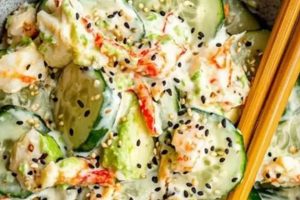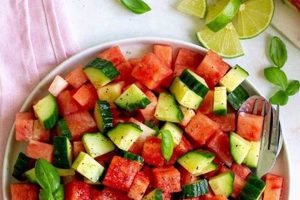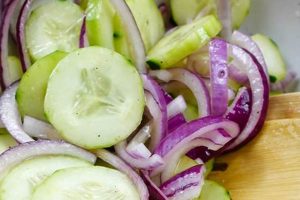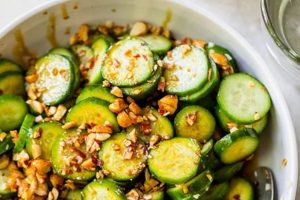Refreshing and flavorful salads featuring cucumber are a staple in Indian cuisine. These dishes range from simple preparations with yogurt and spices to more complex versions incorporating other vegetables, herbs, and chutneys. A typical example might include thinly sliced cucumbers tossed with chopped onions, tomatoes, cilantro, and a dressing of yogurt, cumin, and chili powder.
Such salads offer a cooling counterpoint to spicier main courses, aiding digestion and providing essential vitamins and hydration. Their adaptability allows for variations based on regional preferences and seasonal availability, contributing to the diversity of Indian culinary traditions. Historically, cucumbers, native to India, have played a significant role in the region’s diet, and these salads represent a continued appreciation for this versatile ingredient.
The following sections will explore various regional variations, offer tips for ingredient selection and preparation, and provide detailed recipes to guide culinary enthusiasts in creating their own authentic Indian cucumber salads.
Tips for Preparing Indian Cucumber Salads
Achieving optimal flavor and texture in Indian cucumber salads requires attention to detail throughout the preparation process. The following tips offer guidance for creating authentic and refreshing dishes.
Tip 1: Selecting Cucumbers: Opt for firm cucumbers with smooth skin. Smaller varieties often possess fewer seeds and a more delicate flavor.
Tip 2: Enhancing Flavor: Salt the sliced cucumbers and allow them to rest for a few minutes before adding other ingredients. This draws out excess moisture and intensifies the cucumber flavor.
Tip 3: Balancing Flavors: Achieve a harmonious blend of flavors by combining sweet, sour, salty, and spicy elements. Yogurt or lemon juice provides tartness, while green chilies or chili powder add heat. Sugar or jaggery can be used for sweetness.
Tip 4: Incorporating Fresh Herbs: Fresh cilantro, mint, or curry leaves elevate the aroma and taste. Chop finely and add just before serving for maximum impact.
Tip 5: Choosing Spices: Ground cumin, coriander, and red chili powder are common additions, but experimentation with other spices like chaat masala or roasted cumin seeds can add depth.
Tip 6: Texture Variation: Include chopped onions, tomatoes, or finely shredded carrots for added texture and nutritional value.
Tip 7: Serving Temperature: Serve the salad chilled for maximum refreshment. Avoid over-chilling, as this can dull the flavors.
By following these tips, one can ensure a flavorful and satisfying culinary experience. Attention to these details elevates a simple cucumber salad to a truly authentic and enjoyable component of any Indian meal.
The concluding section will summarize the key elements of preparing exceptional Indian cucumber salads and provide further resources for exploration.
1. Refreshing
The refreshing quality of Indian cucumber salads is a defining characteristic, contributing significantly to their appeal, especially in warmer climates. This attribute arises from a combination of factors, primarily the inherent properties of cucumbers and the complementary ingredients incorporated into the recipes.
- High Water Content
Cucumbers possess a high water content, providing a naturally cooling and hydrating effect. This inherent characteristic makes them ideal for salads consumed in hot weather, offering immediate relief and refreshment. In Indian cuisine, this cooling property is further enhanced by the addition of yogurt or raita, creating a synergistic effect.
- Cooling Herbs and Spices
The inclusion of fresh herbs like mint and cilantro contributes to the refreshing sensation. These herbs possess aromatic compounds that create a cooling perception on the palate. Additionally, spices like cumin, while adding flavor complexity, also contribute to a sense of coolness, particularly when combined with yogurt.
- Balancing Heat
Indian cucumber salads often serve as a counterpoint to spicier main dishes. The cooling nature of these salads helps balance the heat from chilies and other spices, providing a more enjoyable and balanced dining experience. This interplay of contrasting flavors is a hallmark of Indian cuisine.
- Light and Digestible
The light and digestible nature of cucumber salads further contributes to their refreshing quality. Unlike heavier dishes, these salads do not weigh down the palate or induce sluggishness. This makes them ideal for warm weather or as a light accompaniment to a larger meal. The combination of fiber and water aids digestion, promoting a sense of lightness and well-being.
The refreshing aspects of Indian cucumber salads are integral to their role in the broader context of Indian cuisine. They offer a balance to richer, spicier dishes and provide a revitalizing element, particularly appreciated in a warm climate. The combination of high water content, cooling herbs, and spices, and the inherent digestibility contributes to a uniquely refreshing culinary experience.
2. Spice-balanced
The concept of “spice-balanced” is central to understanding the nuances of Indian cucumber salad recipes. It signifies not merely the presence of spices, but a carefully considered combination that creates a harmonious and flavorful experience. This balance often involves a complex interplay of contrasting elements, resulting in a dish that is both refreshing and stimulating.
- Heat and Cooling
A defining characteristic of many Indian cucumber salads is the balance between heat, typically from green chilies or chili powder, and cooling elements like yogurt or cucumber itself. This interplay prevents the heat from overwhelming the palate, creating a pleasant and balanced sensation. A salad featuring finely chopped green chilies tempered by a cooling yogurt dressing exemplifies this balance.
- Earthy and Bright
Ground spices like cumin and coriander provide earthy notes, while fresh herbs like cilantro and mint contribute brighter, more vibrant flavors. This combination creates a layered taste profile that engages the senses without being overpowering. A recipe utilizing roasted cumin powder alongside fresh cilantro demonstrates this duality.
- Tangy and Savory
The incorporation of ingredients like lemon juice or tamarind pulp introduces a tangy element, balancing the savory notes from spices and other vegetables. This interplay of tartness and savoriness adds complexity and prevents the salad from becoming bland. A salad with a lemon-mint dressing illustrates this balance effectively.
- Regional Variations
Spice balance varies regionally across India. Some regions prefer bolder, more assertive flavors, while others favor milder profiles. A South Indian cucumber salad might feature mustard seeds and curry leaves, while a North Indian version might incorporate chaat masala for a tangy-spicy kick. These regional variations highlight the adaptability of spice balancing within the broader context of Indian cuisine.
The careful orchestration of spices within Indian cucumber salad recipes contributes significantly to their unique character. The interplay of contrasting flavors, customized to regional preferences, exemplifies the sophistication and depth of Indian culinary traditions. This emphasis on balance ensures a flavorful and refreshing experience, highlighting the importance of spice not just as an ingredient, but as a defining element of the dish.
3. Versatile Ingredients
The versatility of ingredients in Indian cucumber salads contributes significantly to their adaptability and widespread appeal. This characteristic allows for customization based on individual preferences, regional variations, and seasonal availability. Exploring the multifaceted nature of this versatility provides insight into the dynamic interplay of flavors and textures within these dishes.
- Regional Adaptations
Regional variations in ingredient selection showcase the adaptability of Indian cucumber salads. Coastal regions might incorporate coconut, while inland areas might utilize peanuts or dried fruits. The use of locally sourced ingredients reflects both culinary traditions and the diverse agricultural landscape of India. For example, a South Indian salad might feature curry leaves and mustard seeds, while a North Indian version could include roasted chickpeas and chaat masala.
- Seasonal Adjustments
Seasonal availability influences ingredient choices, showcasing the resourcefulness of Indian cuisine. During summer months, readily available cucumbers might be combined with tomatoes and onions. In cooler seasons, ingredients like carrots or pomegranate seeds might be added. This adaptability ensures access to fresh and flavorful salads throughout the year.
- Customization to Palate
The versatility of ingredients allows for customization to individual preferences. Those seeking a milder flavor profile might opt for yogurt-based dressings and milder spices, while those preferring bolder tastes might incorporate green chilies and more pungent spices. This flexibility allows individuals to tailor the salad to their specific liking.
- Textural Variations
Ingredient choices influence the texture of the salad. The addition of crunchy elements like peanuts or roasted chickpeas provides contrast to the softer cucumbers. The use of different cutting techniques for cucumbers, from thin slices to chunks, further adds textural complexity. These variations create a more engaging and satisfying sensory experience.
The versatility inherent in Indian cucumber salad recipes underscores their adaptability and enduring popularity. This flexibility allows for a wide range of flavor profiles and textural variations, catering to diverse preferences and regional traditions. By embracing this versatility, individuals can create personalized versions of these refreshing and flavorful dishes, showcasing the dynamic nature of Indian cuisine.
4. Regional Variations
Regional variations in Indian cucumber salads demonstrate the diversity of culinary traditions across the subcontinent. These variations reflect local ingredient availability, climate influences, and distinct flavor preferences, resulting in a wide array of interpretations of this refreshing dish.
- North Indian Influences
North Indian cucumber salads often feature ingredients like roasted cumin powder, chaat masala, and sometimes chopped potatoes or chickpeas. The emphasis is often on a balance of tangy and spicy flavors, reflecting the region’s preference for richer, more robust tastes. A common example is a cucumber raita with boondi (crispy chickpea flour drops).
- South Indian Flavors
South Indian variations frequently incorporate coconut, curry leaves, mustard seeds, and green chilies. The use of coconut milk or grated coconut adds a creamy richness, while curry leaves and mustard seeds contribute distinct aromatic notes. A typical example is a kosambari, a type of salad featuring soaked lentils and grated coconut.
- Eastern Indian Nuances
Eastern Indian cucumber salads often highlight mustard oil and panch phoron, a five-spice blend. This combination imparts a pungent and earthy flavor profile, reflecting the region’s affinity for strong aromas and spices. A cucumber salad with mustard oil and chopped green chilies is a simple yet flavorful example.
- Western Indian Adaptations
Western Indian cucumber salads sometimes incorporate peanuts, sesame seeds, and dried spices like ground coriander and cumin. The influence of Gujarati cuisine is evident in the use of sugar or jaggery to balance the savory and spicy elements. A cucumber and peanut salad with a sweet and tangy dressing is a representative example.
These regional variations demonstrate the adaptability of cucumber salad recipes within the broader context of Indian cuisine. They highlight the influence of local ingredients and culinary traditions in shaping distinct flavor profiles, showcasing the rich diversity of Indian gastronomy.
5. Simple Preparation
The simplicity of preparation is a key characteristic of Indian cucumber salads, contributing to their popularity as a quick and refreshing dish. This ease of preparation stems from minimal cooking requirements, readily available ingredients, and straightforward techniques, making these salads accessible to cooks of all skill levels. Understanding the facets of this simplicity provides insight into the efficiency and adaptability of these recipes.
- Minimal Cooking
Indian cucumber salads typically require little to no cooking, relying primarily on fresh ingredients. This eliminates the need for extensive heat and reduces preparation time significantly. A simple salad might involve only chopping cucumbers, onions, and tomatoes, followed by a quick mixing of spices and yogurt. This minimal cooking preserves the fresh flavors and textures of the ingredients.
- Readily Available Ingredients
The ingredients for most Indian cucumber salads are commonly found in Indian households or easily accessible in local markets. Cucumbers, onions, tomatoes, cilantro, and common spices like cumin and chili powder form the base of many recipes. This ease of access further contributes to the convenience and simplicity of preparation.
- Straightforward Techniques
Preparation techniques for these salads are generally straightforward, involving basic chopping, slicing, and mixing. Specialized equipment or complex culinary skills are not required. This simplicity makes these salads ideal for everyday meals or as a quick accompaniment to more elaborate dishes.
- Adaptability and Improvisation
The simple nature of these recipes allows for considerable adaptability and improvisation. Ingredient substitutions based on availability or preference are common. Variations in spice levels and the addition of other vegetables or herbs allow for personalized versions. This flexibility enhances the appeal and practicality of Indian cucumber salads.
The simplicity of preparation associated with Indian cucumber salads enhances their appeal as a versatile and convenient dish. Minimal cooking, readily available ingredients, and straightforward techniques contribute to the ease and speed with which these salads can be created. This characteristic makes them a practical and refreshing addition to a wide range of meals, from simple everyday fare to more elaborate feasts.
Frequently Asked Questions
This section addresses common inquiries regarding Indian cucumber salads, providing concise and informative responses.
Question 1: Can different types of cucumbers be used in these salads?
While English cucumbers are commonly used, other varieties like Persian or Kirby cucumbers can also be incorporated. Consider the cucumber’s seed content and skin thickness when selecting a variety.
Question 2: How can one reduce the spiciness of the salad?
Reduce or omit the amount of green chilies or chili powder used. Increase the amount of yogurt or add a touch of sweetness with sugar or jaggery to further balance the heat.
Question 3: What are suitable alternatives to yogurt in the dressing?
Vegan alternatives like coconut milk or cashew cream can be substituted for yogurt. Lemon juice or tamarind pulp can also provide a tangy element in place of yogurt.
Question 4: How long can these salads be stored?
These salads are best consumed fresh. If storage is necessary, refrigerate for no more than 24 hours. The texture and flavor may change slightly upon refrigeration.
Question 5: Are there gluten-free variations of these salads?
Most Indian cucumber salads are naturally gluten-free. Ensure that any added spices or seasonings do not contain gluten-containing ingredients.
Question 6: Can these salads be served as a main course?
While typically served as a side dish or accompaniment, these salads can be a light main course, especially during warmer months. Adding ingredients like chickpeas, lentils, or paneer can increase the protein content and make the salad more substantial.
Understanding these common inquiries facilitates successful preparation and enjoyment of Indian cucumber salads, highlighting the adaptable and versatile nature of these dishes.
Further exploration of specific regional variations and ingredient combinations can enhance appreciation for the diverse world of Indian cucumber salads.
Cucumber Salad Indian Recipes
Exploration of cucumber salad Indian recipes reveals a diverse culinary landscape, highlighting the adaptability of this simple yet refreshing dish. From the careful balance of spices to the regional variations in ingredients and preparation methods, these salads showcase the ingenuity and resourcefulness of Indian culinary traditions. The ease of preparation, combined with the nutritional value and refreshing qualities, further contributes to the enduring appeal of these salads across various regions and palates. Key aspects examined include the selection of cucumbers, balancing flavors, incorporating fresh herbs and spices, achieving textural variation, and understanding regional influences.
The continued evolution of cucumber salad Indian recipes demonstrates the dynamic nature of culinary traditions. Further exploration of regional nuances and creative adaptations promises a deeper understanding and appreciation of this versatile dish within the broader context of Indian gastronomy. This exploration encourages culinary experimentation and a renewed appreciation for the refreshing simplicity and flavorful complexity of cucumber salad Indian recipes.






